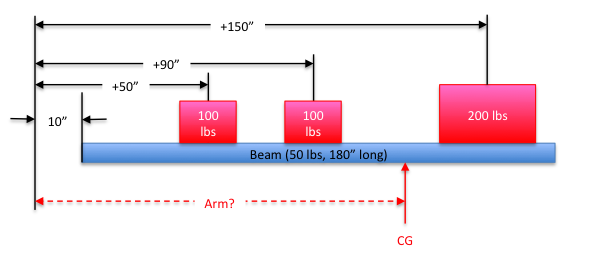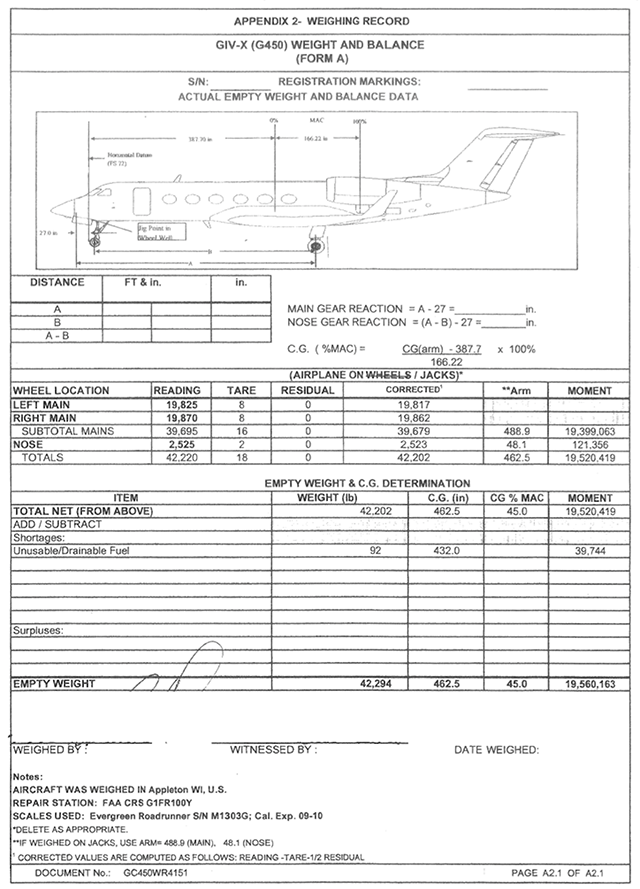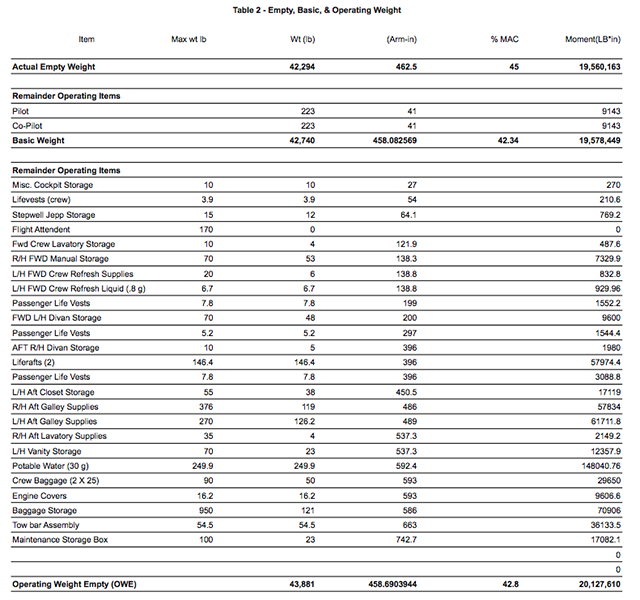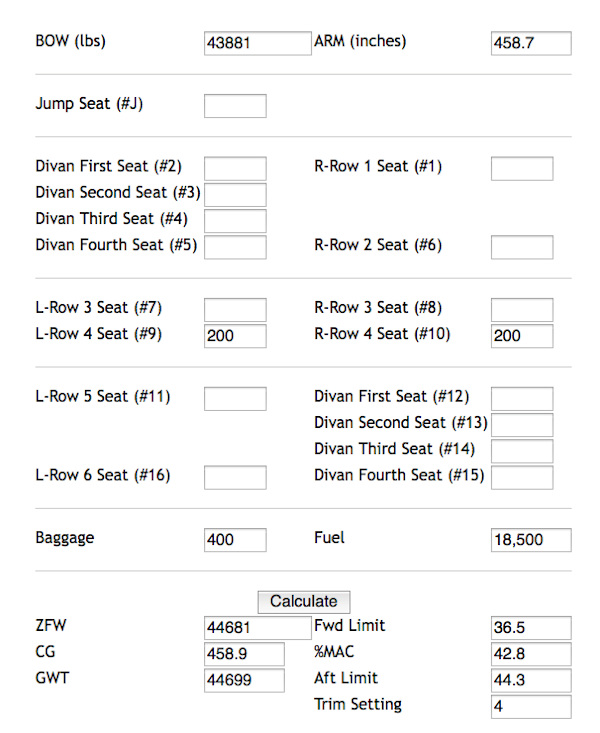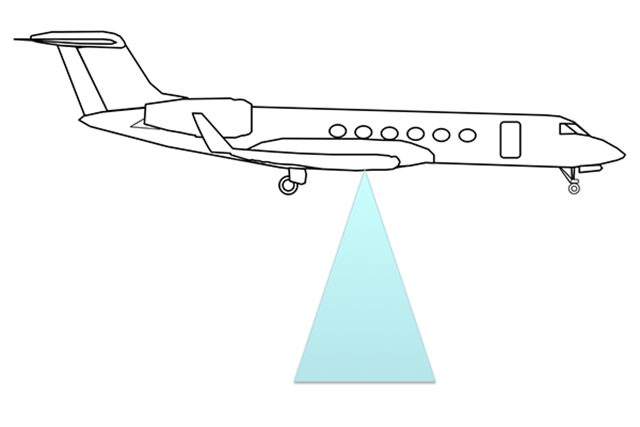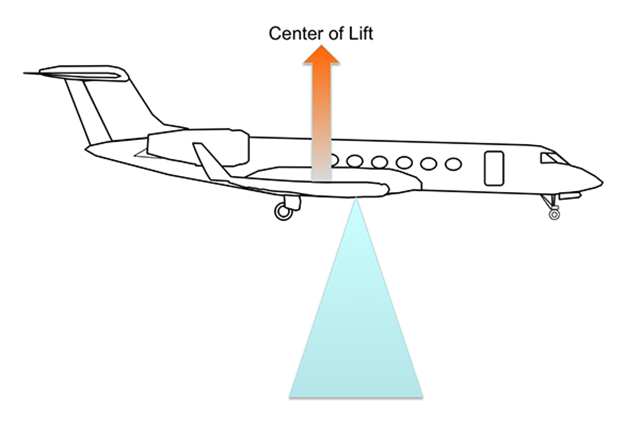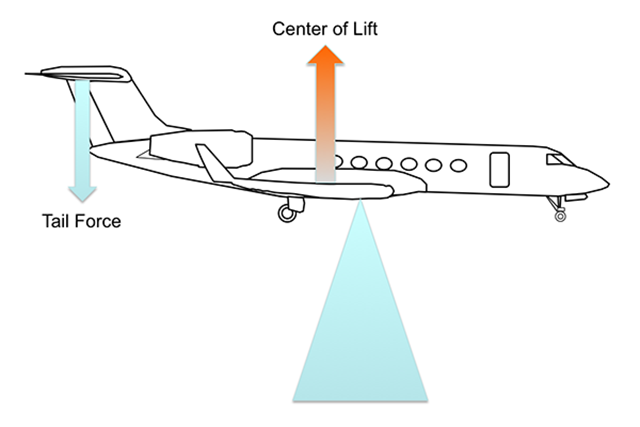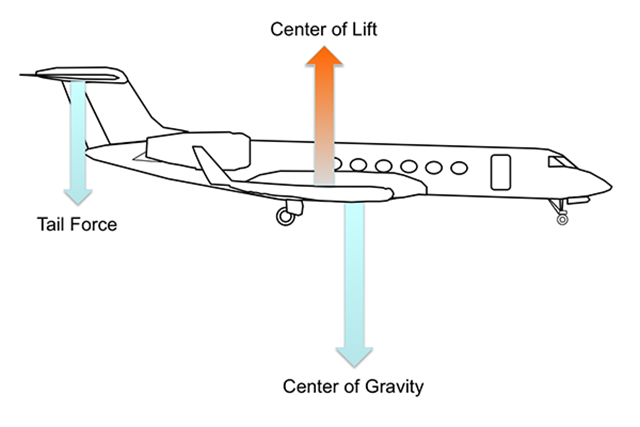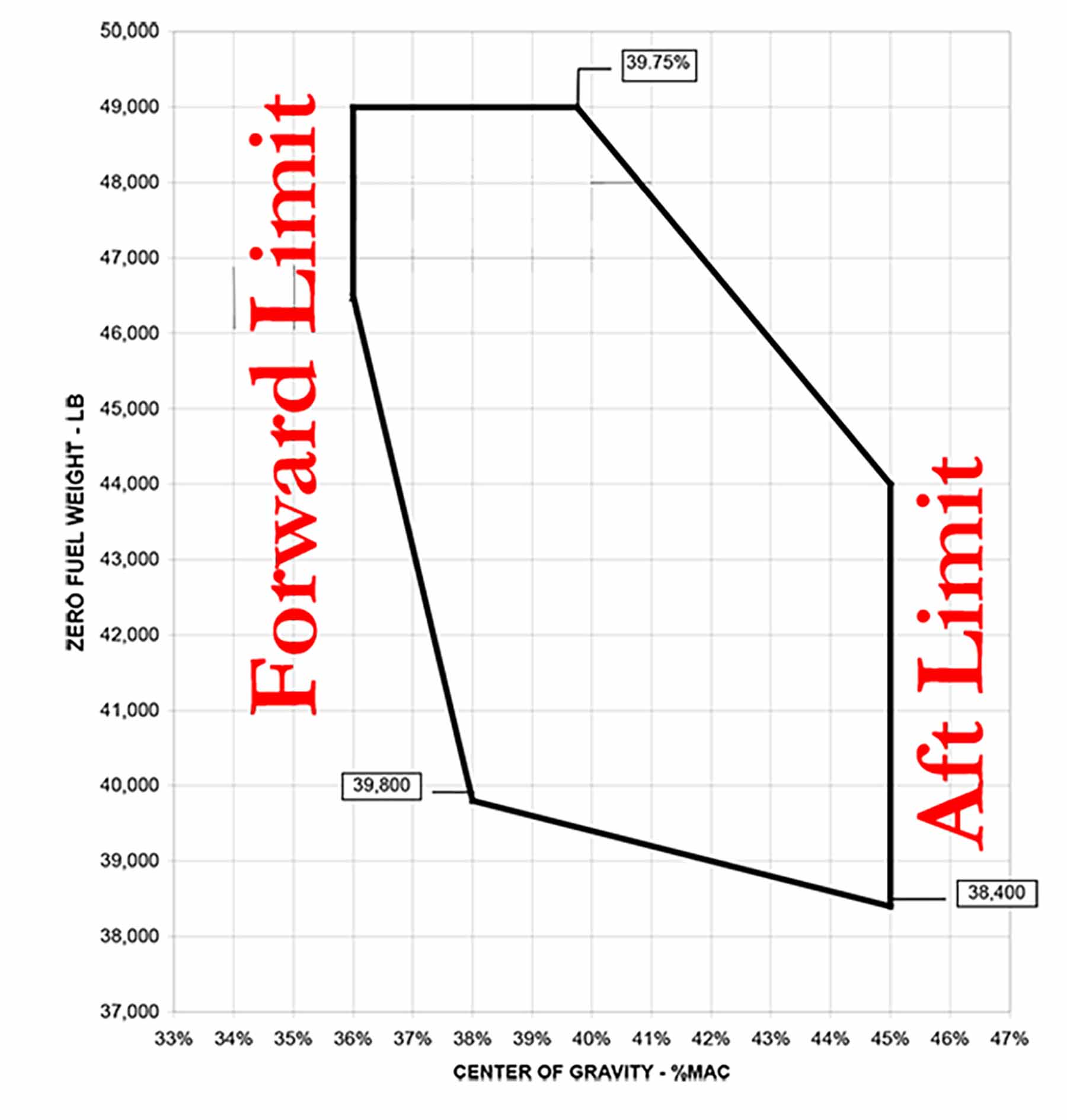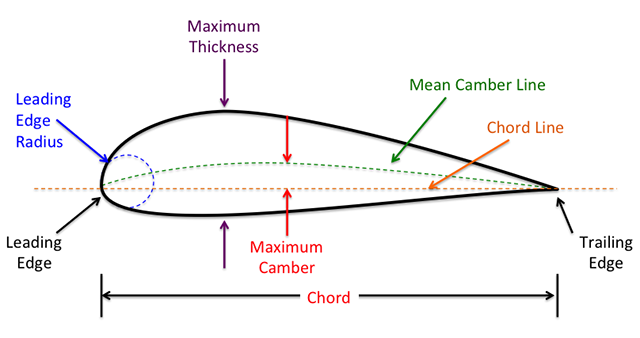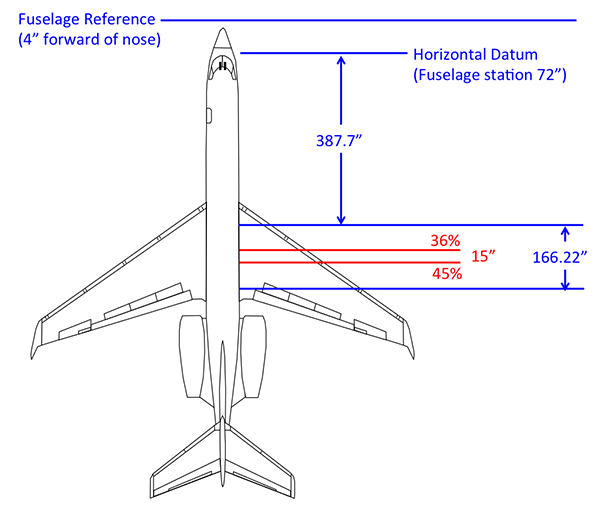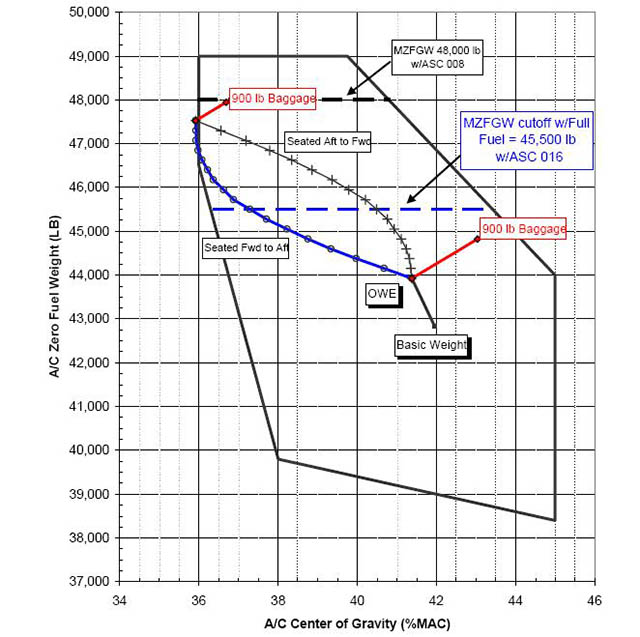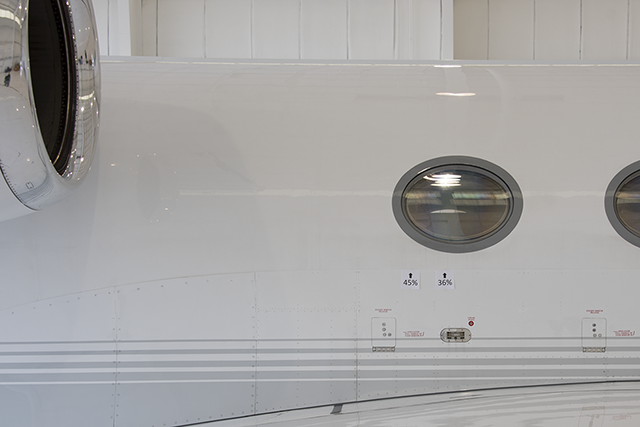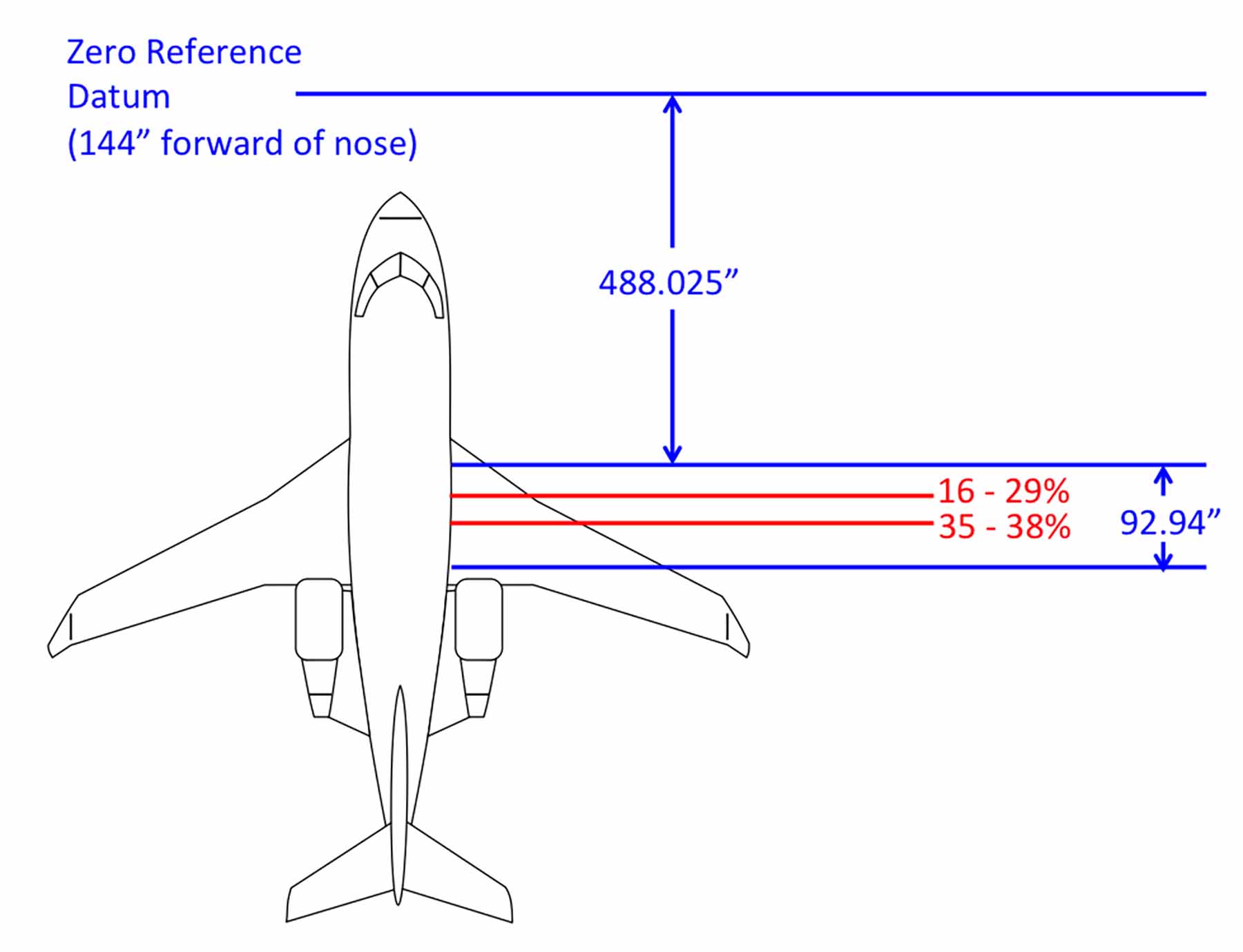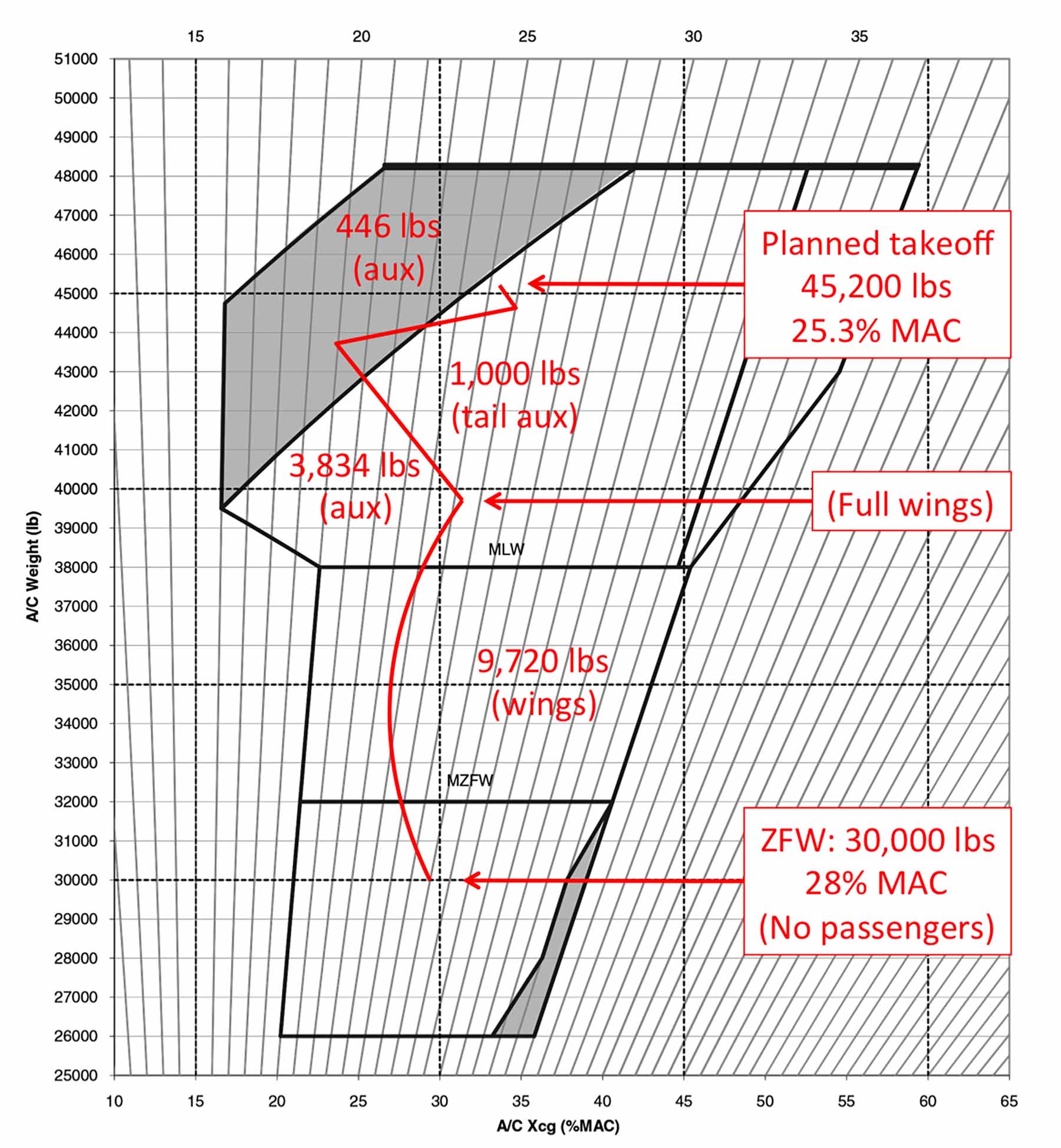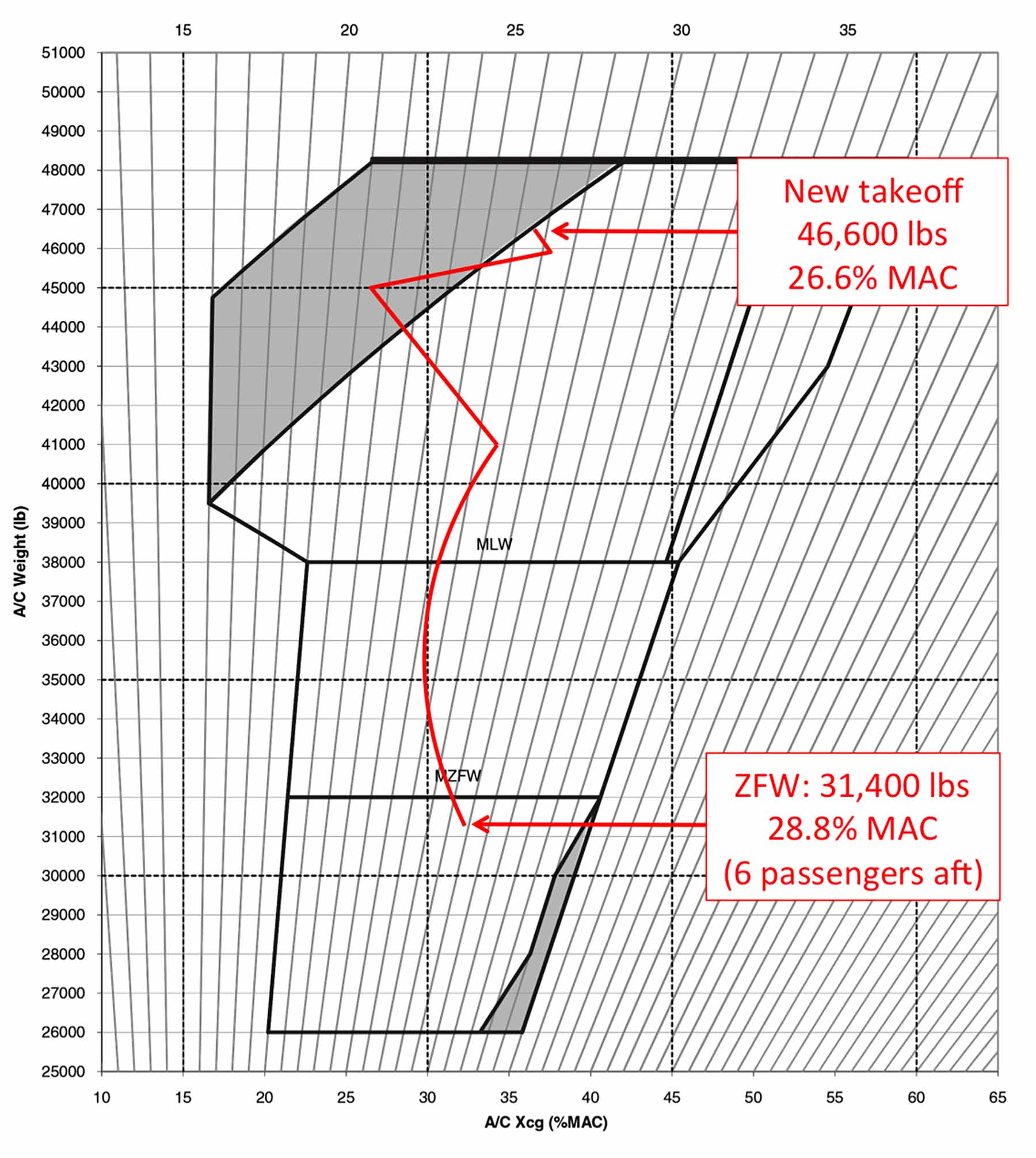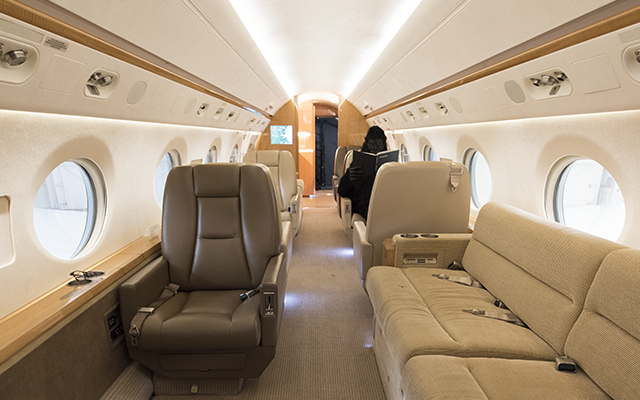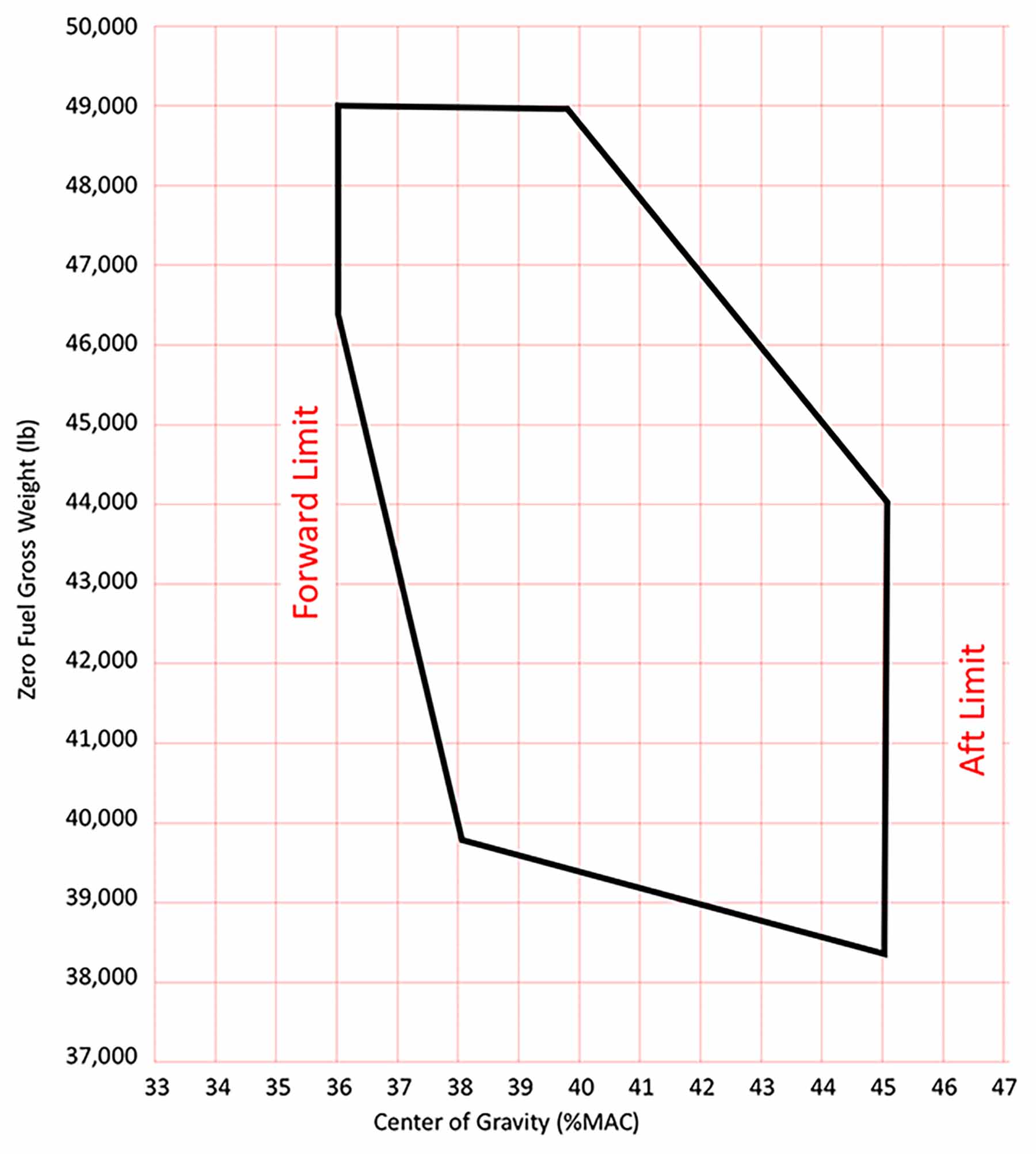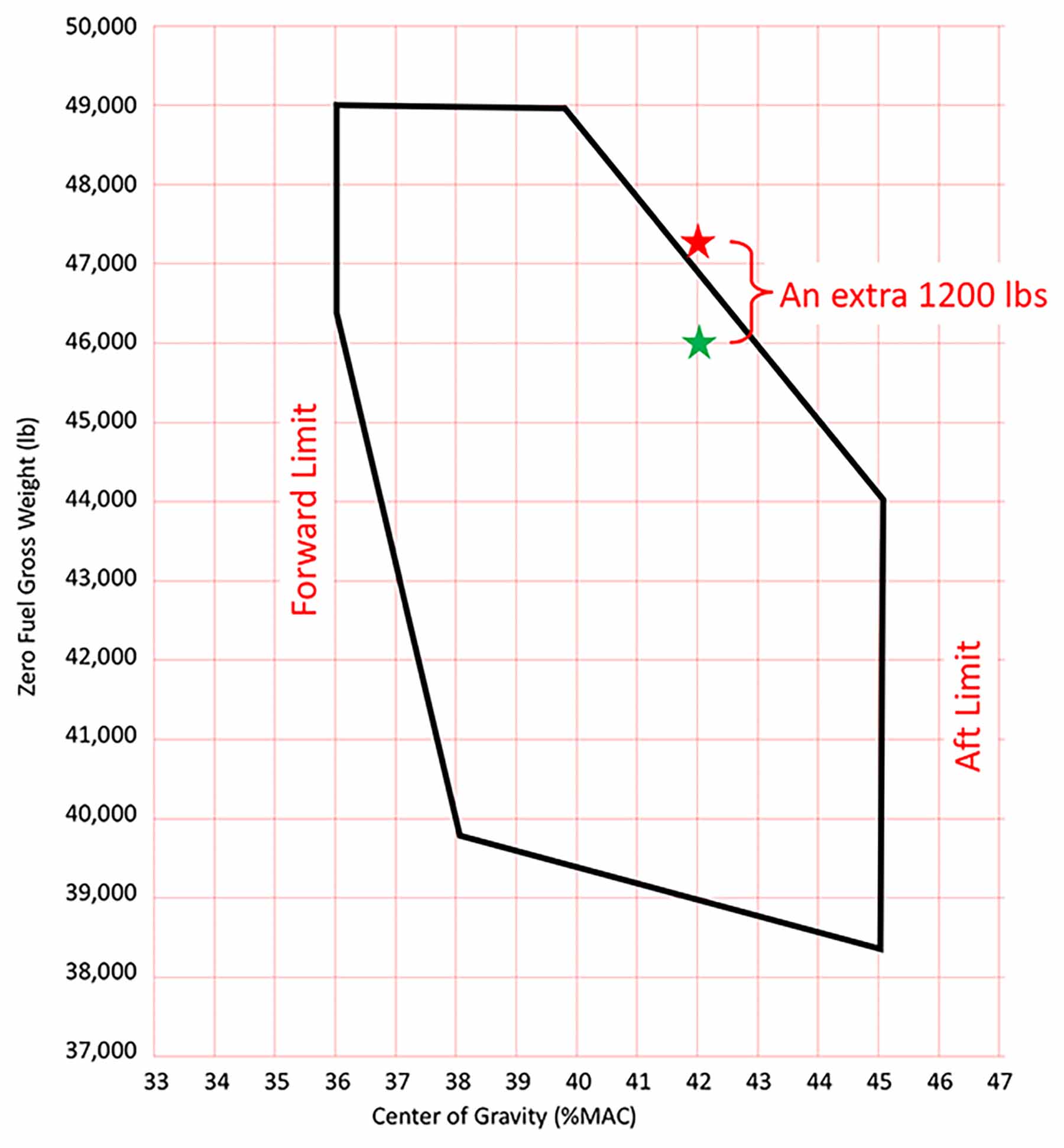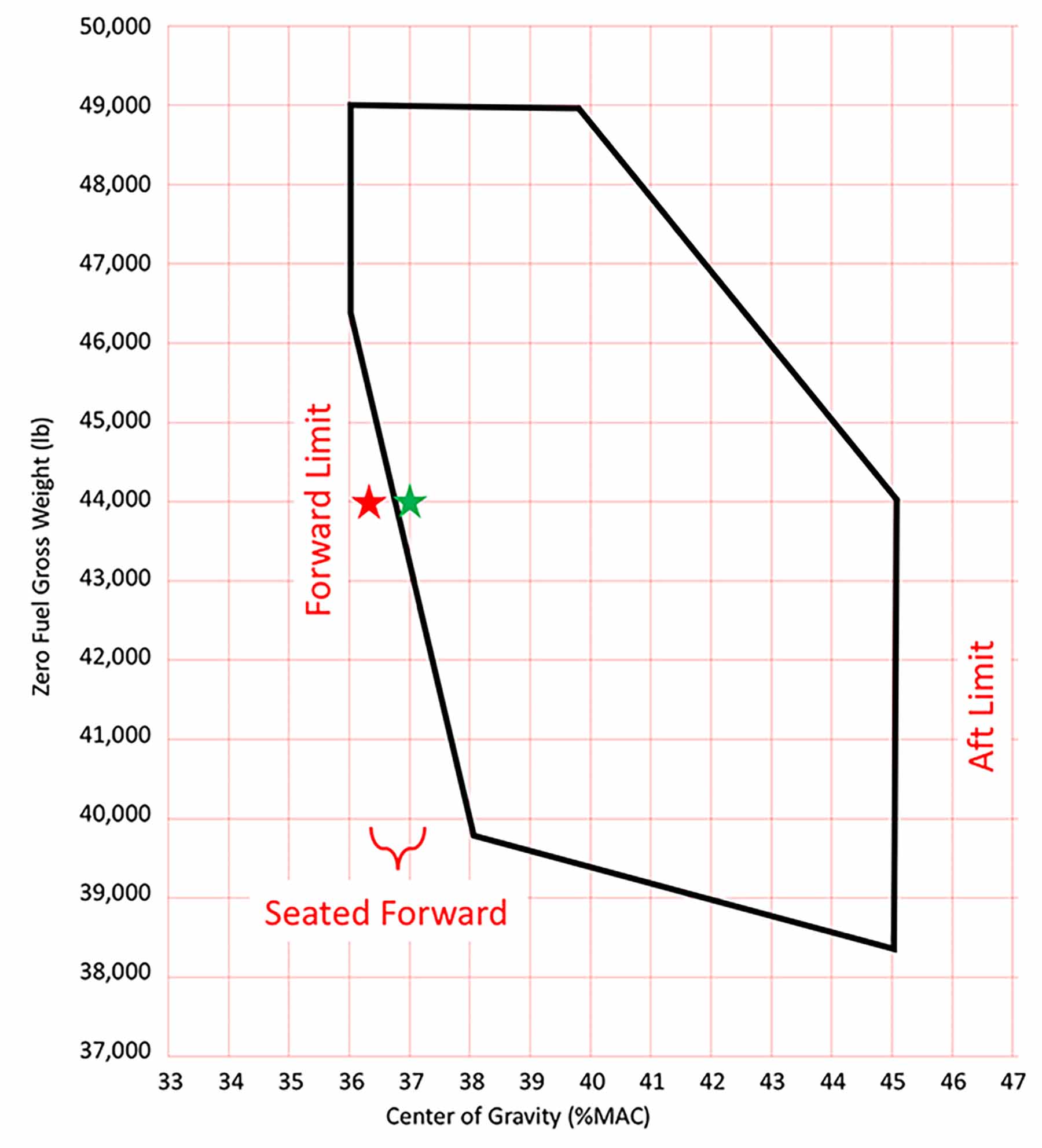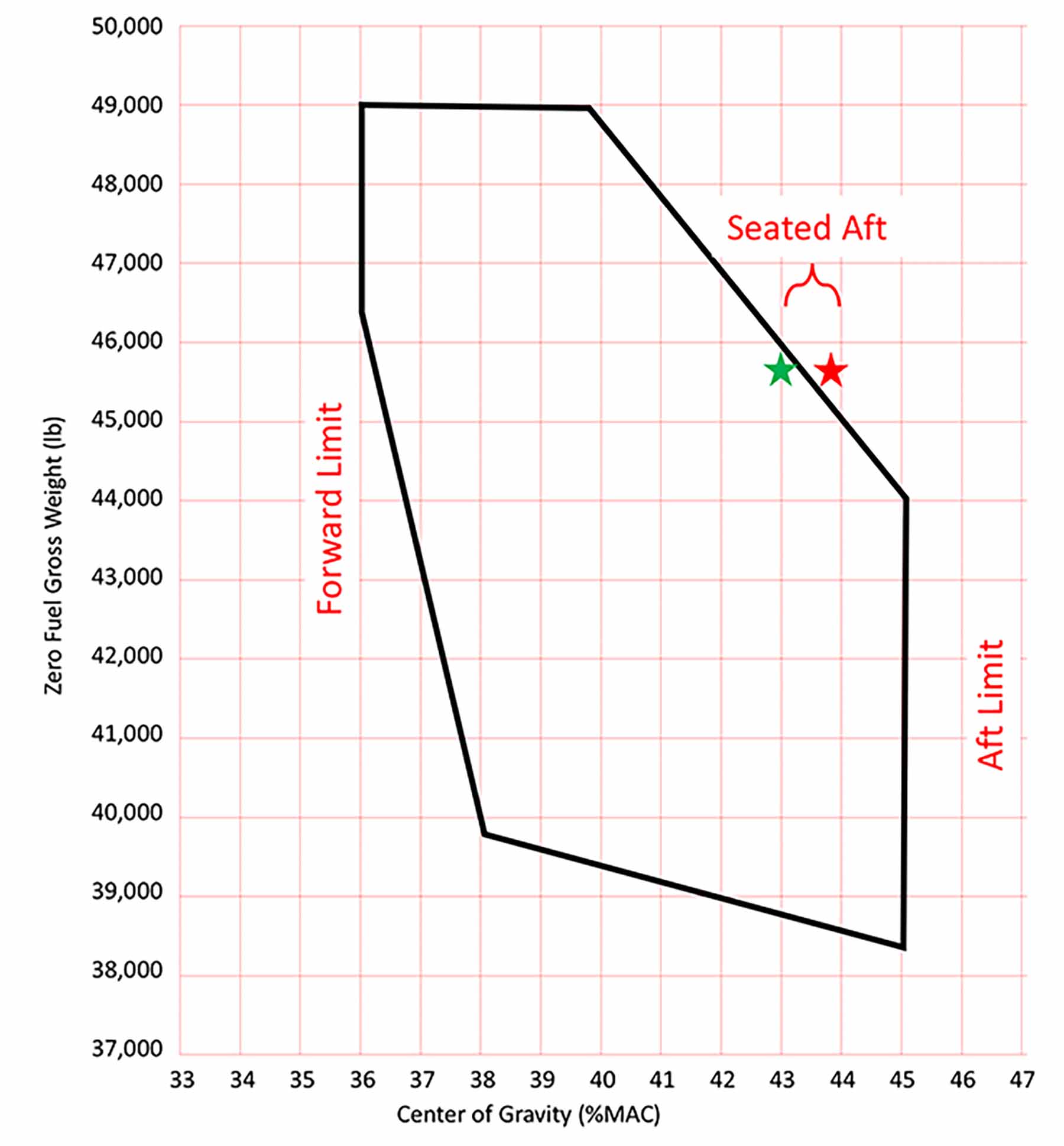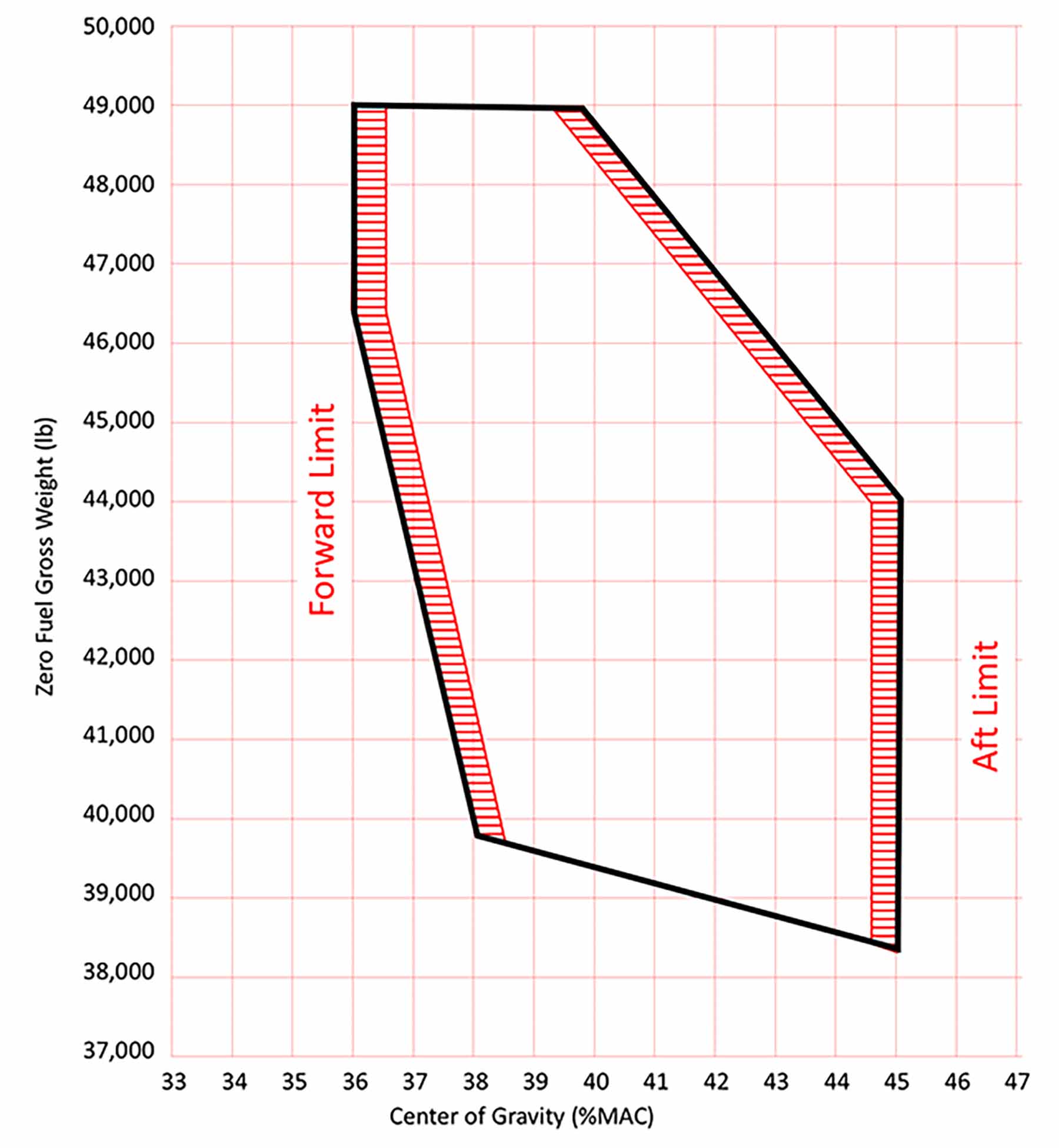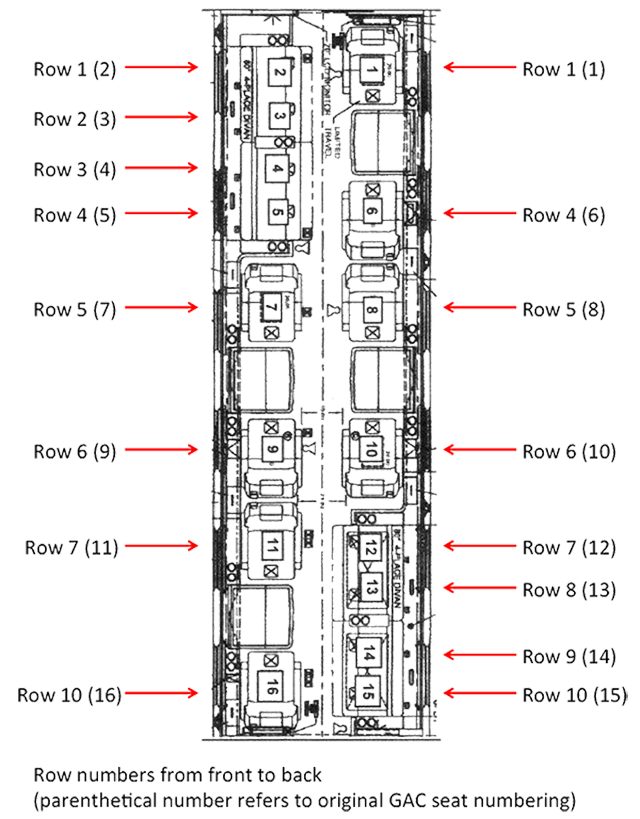Weight and balance is a very big deal on some aircraft and it is possible to load fuel, cargo, or people so the aircraft simply will not fly. See: CL-600 N370V for an example. On other aircraft, such as our oft-used example Gulfstream G450, aircraft design makes it harder to find the airplane un-flyable but it still needs to be considered.
— James Albright

Updated:
2016-06-01
In either case, you should have complete understanding of the concepts and a very good idea of where your airplane's range of acceptable centers of gravity lie. Why? An aircraft with a conventional tail-mounted horizontal stabilizer uses that stabilizer to exert a downward force. The aircraft's "center of lift" exerts an upward force, so the center of gravity (CG) must at all times be forward of the center of lift to keep the aircraft in stable flight. There exists a range of CG positions which the horizontal stabilizer is capable of countering. If the CG is too far either way, the aircraft cannot be controlled in pitch.
We all seem to be weight and balance experts with a Cessna 150 or Piper Cherokee because that's where we learned the concepts and it seems most textbooks are aimed to the private pilot audience. On a larger jet that are several other concepts to wrestle with and everyone assumes the knowledge exists. I'll try to bridge the gap here.
3 — Getting a sense of your balance

1
Basic Principles
The beam and fulcrum
Adapted from Air Force Manual 51-9, chapter 7.
The Air Force teaches its flight engineers weight and balance starting with a beam on a fulcrum in perfect balance. If you place the exact center point of the beam over the fulcrum, the beam should be balanced.
If you add equal weights to each side, the beam will remain in balance as long as the distance from the center for both weights is the same.
The lever law says the product on one weight (W1) multiplied by its distance (D1) from the fulcrum is equal to the product of the other weight (W2) multiplied by its distance (D2) from the fulcrum. Each side of the beam acts as a lever, producing torque about the fulcrum equal to the other.
Source: Air Force Manual 51-9, ¶7-3.b.
The Weight X Distance is indeed the torque about the fulcrum, but to a pilot it more accurately describes the moment of the weight.
The mathematical relationship true even when using different weights. For example, to balance the beam, a 6-pound weight has been place 5 inches from the fulcrum, and a 3-pound weight, 10 inches from the fulcrum. Now, if the law of the lever is applied, we have:
Since the same torque -- 30 inch pounds -- applies to each side of the beam, the beam balances.
Center of Gravity (CG) calculation
Adapted from FAA-H-8083-1A, page 2-2.
What if we don't have a fulcrum and need to determine where the center of gravity is? We need to know: the distance of each object from a common point, called the datum, the weight of each object, and the weight and length of the object itself. Then it is a matter of some math. For example:
- We have a 180" beam that weighs 50 lbs.
- We use 10" forward of the beam as our arbitrary datum line. This means the center of our beam is at (180 / 2) + 10 = 100".
- We place two 100-lb weights on the beam, one is 50" from the datum line, the other is 90" from the datum line.
- We place a 200-lb weight on the beam, 150" from the datum line.
Where along the beam is the CG?
To solve this problem:
- Determine the moment of each object (Moment = Weight X Arm)
- Add all the weights
- Add all the moments
- Divide the total moment by the total weight to find the CG
We typically do this with a table constructed thusly:
| Item | Weight | X | Arm | = | Moment | CG |
| 1st Weight | 100 | X | 50 | = | 5,000 | |
| 2nd Weight | 100 | X | 90 | = | 9,000 | |
| 3rd Weight | 200 | X | 150 | = | 30,000 | |
| Beam | 50 | X | 100 | = | 5,000 |
Adding all the weights and moments:
| Item | Weight | X | Arm | = | Moment | CG |
| 1st Weight | 100 | X | 50 | = | 5,000 | |
| 2nd Weight | 100 | X | 90 | = | 9,000 | |
| 3rd Weight | 200 | X | 150 | = | 30,000 | |
| Beam | 50 | X | 100 | = | 5,000 | |
| 450 | 49,000 |
Dividing the total moment by the total weight:
| Item | Weight | X | Arm | = | Moment | CG |
| 1st Weight | 100 | X | 50 | = | 5,000 | |
| 2nd Weight | 100 | X | 90 | = | 9,000 | |
| 3rd Weight | 200 | X | 150 | = | 30,000 | |
| Beam | 50 | X | 100 | = | 5,000 | |
| 450 | 49,000 | 108.89 |
Based on this information, we know placing our fulcrum at 108.89" will allow this beam to perfectly balance. Note that each weight is considered to impact the beam at the center of the weight. For long weights you need to consider where the center of gravity of the object itself lies to determine its individual arm.
The beam itself is analogous to an airplane, except the airplane is not a uniform structure so you cannot simply assume its arm lies at the halfway point, as we did with the beam.
Another analogous issue is the reference datum. We normally place this fictitious line ahead of anything on the airplane that is subject to changes. Doing so eliminates negative arms and simplifies the math.
Reference datum
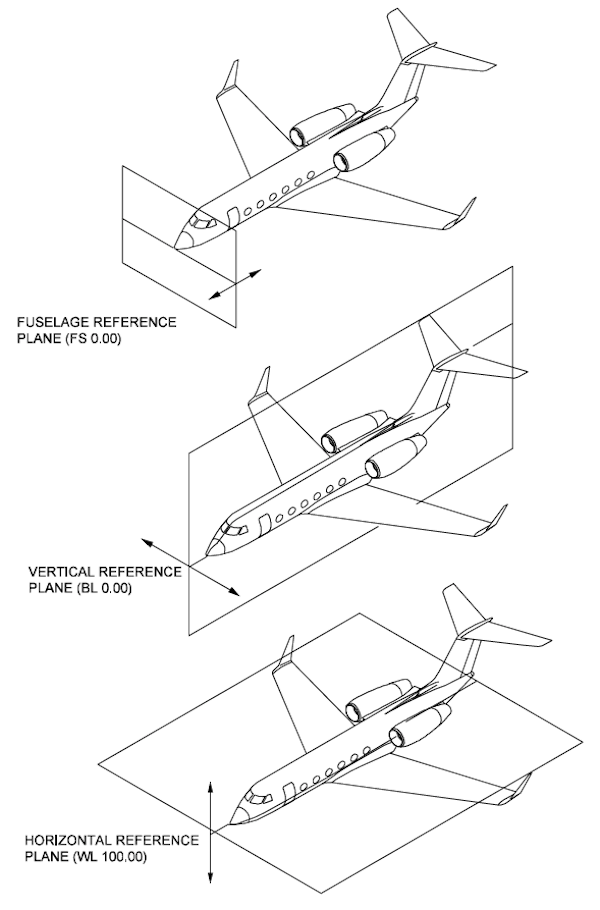
G450 fuselage coordinate system, from G450 Maintenance Manual, §06-10-00, figure 1.
- The manufacturer establishes the maximum weight and range allowed for the CG, as measured in inches from the reference plane called the datum. Some manufacturers specify this range as measured in percentage of the mean aerodynamic chord (MAC), the leading edge of which is located a specified distance from the datum.
- The datum may be located anywhere the manufacturer chooses; it is often the leading edge of the wing or some specific distance from an easily identified location. One popular location for the datum is a specified distance forward of the aircraft, measured in inches from some point, such as the nose of the aircraft, or the leading edge of the wing, or the engine fire wall.
Source: FAA-H-8083-1A, page 2-1
2
Aircraft example
The Gulfstream G450 makes a good learning example since there are only two fuel tanks and the aircraft was designed so that if the zero fuel CG is within takeoff limits, any added fuel will be too.
FS represent edges of vertical planes perpendicular to the horizontal reference plane in side view and perpendicular to the vertical reference plane in plan view. FS dimension and location points in the FCS from FS 0, begin 4 inches aft of the forward tip of the nose radome. FS show measurement of length along the longitudinal axis (X).
Source: G450 Maintenance Manual, §06-10-00, ¶2.A.
Horizontal datum: FS 72.
Source: G450 Weight and Balance Manual, page 16.
From a pilot's perspective the use of a reference datum line that is effectively +4 -72 = 68" aft of the forward tip of the nose radome is inconsequential unless there is a change to something in the radome. If that were to happen the aircraft's empty center of gravity may have to be adjusted.
Horizontal arms
Everything on the airplane is weighed and the effective center of that weight measured against the Reference Datum Line. If, for example, the center of a passenger seat is located 400" from the reference datum line, an occupant of that seat will be computed as being entirely at 400".
Horizontal Arm, measured in inches, is used for the location of components and complete aircraft weight and center of gravity (C.G.) purposes.
Source: G450 Weight and Balance Manual, ¶2.1.2.5

Mean Aerodynamic Chord, from FAA-H-8083-1A, figure 3-9.
The aircraft mechanic or repairman is primarily concerned with the location of the CG relative to the datum, an identifiable physical location from which measurements can be made. But because the physical chord of a wing that does not have a strictly rectangular plan form is difficult to measure, wings such as tapered wings express the allowable CG range in percentage of mean aerodynamic chord (MAC). The allowable CG range is expressed in percentages of the MAC. The MAC, as seen in Figure 3- 9, is the chord of an imaginary airfoil that has all of the aerodynamic characteristics of the actual airfoil. It can also be thought of as the chord drawn through the geographic center of the plan area of the wing.
Source: FAA-H-8083-1A, page 3-6
The center of gravity, for most aircraft, lies somewhere between LEMAC and TEMAC so you can convert the position of the CG from the reference datum to a percentage of the mean aerodynamic chord using the following formula:
In the case of our example Gulfstream:
Mean Aerodynamic Chord MAC). The location of the airplane center of gravity as a percentage of MAC is an alternative to Horizontal Arm.
Source: G450 Weight and Balance Manual, ¶2.1.2.7
Moment
A moment is a force that tries to cause rotation, and is the product of the arm, in inches, and the weight, in pounds. Moments are generally expressed in pound-inches (lb-in) and may be either positive or negative.
Source: FAA-H-8083-1A, page 2-1
The larger the aircraft in terms of inches nose-to-tail or weight in terms of pounds or hundreds of thousands of pounds, the moment calculation can become cumbersome. A Boeing 747, for example, could have a center of gravity 960" behind the reference datum line and a weight of 800,000 pounds. The aircraft's total moment would in this case be 768,000,000 lb-in. Boeing recommends all moments be divided by 100,000 to get rid of all those zeroes. This reduces the chance of error and makes calculations possible on most electronic calculators. The 100,000 factor is by no means universal. You should consult your aircraft manuals. For example . . .
Moment (10,000 (lb*in)), to avoid large moment numbers in balance calculations, moments (Weight X Horizontal Arm) can be divided by 10,000. Moment is given in pound-inch units.
Source: G450 Weight and Balance Manual, ¶2.1.2.6
Aircraft basic weight and CG
Manufacturers have some leeway in how they determine the aircraft's empty weight and center of gravity. You should know what goes into the numbers they provide you. In our example G450, Gulfstream weighed the airplane without most of the operator provided equipment. "If you can carry it off the airplane without getting your tools," is how we think about it, "it isn't in the empty weight." The operator is provided this information on what Gulfstream calls a Weight and Balance Form A:
The example aircraft was weighed at each landing gear, the weights were multiplied by their respective arms to come up with moments. The moments were added (19,520,419) and divided by the total weight (42,202) to come up with a CG of 465.5 inches behind the datum line. Since Gulfstream wants the empty weight to include unusable fuel, that is added. The published empty weight becomes 42,294 lbs with a moment arm of 19,560,163 inch-pounds. After division we see that the aircraft's empty CG is 462.5 inches behind the reference datum, or 45.0% MAC.
Aircraft operating empty weight and CG
Of course we cannot fly without pilots, so they are added on the next form (using an average weight) to give us our Basic Weight of 42,740 lbs with a new total moment and resulting CG.
Next we add everything else, except fuel, to determine our Operating Weight Empty, also known as the "Basic Operating Weight" or BOW.
Aircraft ramp weight, CG, trim setting
Procedures will vary from aircraft manufacturer but in the case of our example Gulfstream G450, we can add personnel, baggage, and fuel using a spreadsheet, slide rule, or computer application.
CG limits

G450 Zero fuel gross weight CG envelope, from G450 Weight and Balance Manual, ¶2.4.
Ranges of weights and centers of gravity within which the airplane may be safely operated must be established. If a weight and center of gravity combination is allowable only within certain load distribution limits (such as spanwise) that could be inadvertently exceeded, these limits and the corresponding weight and center of gravity combinations must be established.
Source: 14 CFR 25, §25.23(a)
It is up to the manufacturer how the ranges of weights and centers of gravity are presented. In the case of the example G450, Gulfstream presents a chart with both ranges displayed without fuel. They further stipulate that if the aircraft is within limits with no fuel, it will always be within limits with fuel. (This is uncommon in the world of jets.) In our example, the aircraft's zero fuel weight is 44,699 lbs and the center of gravity is at 42.8% MAC, which is well inside the chart's borders so our aircraft is within its weight and balance envelope.
3
Getting a sense of your balance
Weight and balance tends to be a math intensive subject and you should understand the principles. Because some airplanes are more sensitive than others and even those that are center-of-gravity-sensitive tend to be okay most of the time, we tend to let our guards down on this subject. That is too bad, because getting weight and balance wrong can be deadly.
Even if you aren't a math wizard, having a "feel" for weight and balance can come in handy. If you can visualize where on your airplane the center of gravity resides, the forward and aft limits of your center of gravity, and how the seats and fuel tanks all relate to those points, you will have the skills you need to approach your weight and balance sensually. Sensually? Yes: weight and balance by feel.
This is a subject normally covered in aircraft initial and perhaps briefly during recurrent training. Most pilots can struggle through the formulas if given a cheat sheet and certainly the more conscientious fill out the blocks on an EFB application and can generate the necessary numbers. But you really need to understand what happens to your CG when things change.
Balance
If you could place the airplane on a point so that it remains level, you will have found the center of gravity for that airplane as currently loaded.
With any kind of relative wind over the wing you will have an aerodynamic force which can be broken into two components. The component that operates perpendicular to the relative wind is known as lift. Just as you can visualize the airplane's center of gravity going through one point along the fuselage, you can also visualize all of the lift generated in an upward direction as the "center of lift." An airplane with a conventional layout — wing in the middle, tail in the back — the center of lift will be behind the center of gravity.
Of course having the center of lift behind the center of gravity induces a pitch down moment. We counteract that moment with a downward force from the tail. You might think the ideal arrangement would be to have the center of lift precisely over the center of gravity and have no tail at all. This would work in theory until any kind of movement within the aircraft moves the center of gravity. The tail is necessary to compensate for these movements and to give the pilot some pitch control over the airplane.
If we replace our balancing pyramid with a graphical representation of our center of gravity, we will have the classic illustration of the weight and balance problem. Our task as pilots is to always keep the center of gravity forward of the center of lift, but not so far forward that we overwhelm the amount of downward force available from the tail.
In the example center of gravity chart, we see our G450 has an aft limit of 45% MAC and a forward limit of 36% MAC. In the case of a takeoff problem, we know that too far aft will mean the nose will rotate on its own and we won't be able to keep the airplane from pitching up regardless of our inputs, and too far forward we won't be able to rotate at all. But where exactly are these points?
Limits
The limits of your longitudinal center of gravity are determined by where exactly the airplane's center of lift resides and how much elevator authority you really have. The manufacturer gives these numbers to you in terms of a percentage of the mean aerodynamic chord, but what does that really mean?
The MAC is the "Mean Aerodynamic Chord" of the wing. The chord is simply a line drawn from the leading edge of the wing to the trailing edge. Of course most aircraft have wings that change shape from the fuselage outward to the wing tip. The mean aerodynamic chord is an average of all the chord lines from root to tip.
For more about this, see Lift.
We can better visualize the limits of our center of gravity by looking at a bird's eye view of the aircraft.
Gulfstream chose a reference point 4" forward of the nose and all manufacturing measurements take place from this imaginary point. They then drew a horizontal reference datum 72" behind that. In the case of our G450:
- The Leading Edge of the Mean Aerodynamic Chord (LEMAC) is 387.7" aft of the horizontal datum.
- The Trailing Edge of the Mean Aerodynamic Chord (TEMAC) is 166.22" aft of the LEMAC.
- The forward limit of our CG is 36% of the MAC, or 59.84" behind LEMAC.
- The aft limit of our CG is 45% of the MAC, or 74.80" behind LEMAC.
- The distance between the forward and aft limit is 74.80 - 59.84 = 14.96".
- Our CG must reside within those meager 15".
This may not seem like much, but this Gulfstream's fuel tanks are all in the wings and the airplane is certified to allow C.G. computations without regard to fuel. Even without the first drop of fuel on board the airplane weighs nearly 43,000 lbs. So getting outside this 15" when you are dealing with 14 people who weigh on average only 200 lbs will take some doing.
4
CG-sensitive or CG-insensitive?
Not all airplanes are created equal and when it comes to weight and balance, you have to worry more about some than others.
CG-Insensitive
In the case of our G450, a typical airplane with a 42% basic %MAC can load 900 lbs of baggage in the furthest aft location and still be okay. From that point passengers can be loaded aft-to-front or front-to-aft and the airplane will still be within tolerances. (The furthest aft seat is still forward of the center of gravity, so any passenger at all brings this CG forward.
Note: A G450 with a forward galley may run into forward CG issues.
This particular center of gravity chart is used for takeoff computations and does not include fuel. Gulfstream found that the wing-only fuel arrangement will not put the airplane out of CG no matter the quantity of fuel, and was able to certify it this way. While fuel loading does impact takeoff trim, it can never place the airplane in an unacceptable CG range.
This particular G450 can be said to be "CG-insensitive," it can tolerate wide movements of passengers, baggage, and fuel and still be within CG limits. It is helpful to know how sensitive your airplane is.
CG-Sensitive
A Challenger 605 can be said to be "CG-sensitive." While it can tolerate movements of passengers, baggage, and fuel and still be within CG limits, it can also find itself out of limits without too much effort. With fuel distributed from nose to tail those 605's with forward galleys tend to be nose heavy. Fuel mismanagement can also jeopardize a safe balance:
- In a typical 600-series Challenger, about half the seats are forward of the CG, half are aft. Where you seat passengers matters.
- Fueling the wings only will start to move the CG forward but at about the halfway point moves it aft.
- After the wings are full, fuel should be computer controlled to distribute between the auxiliary and aft-auxiliary tanks in a 2.65 to 1 ratio. That generally moves the CG forward.
- After the auxiliary tank is full, the rest of the fuel goes to the aft-auxiliary tank and then to the saddle and tail cone tanks. All of that tends to move the CG aft.
This is a lot to consider when you are making changes. Most of these airplanes have forward galleys and tend to be nose heavy until they become very heavy. This airplane is CG-sensitive.
Impacts
Your center of gravity will be impacted by where on the aircraft you have stored fuel, cargo (baggage), and people. When these things move around, so does the center of gravity. Understanding where the CG moves is key to having a feel for your airplane's weight and balance.
CG-insensitive Example (G450)
In the case of our example CG-insensitive G450:
- The LEMAC is 387.7" behind the horizontal datum.
- The forward-most center of gravity allowed is 36% of MAC (166.22") which comes to 59.8". That means the forward-most center of gravity allowed is 387.7 + 59.8 = 447.5" aft of the horizontal datum.
- The aft-most center of gravity allowed is 45% of MAC (166.22") which comes to 74.8". That means the aft-most center of gravity allowed is 387.7 + 74.8 = 462.5" aft of the horizontal datum.
- The aft-most seat on a typical G450 is 426" behind the horizontal datum.
- The cabin door in front of the aft baggage compartment is 555" behind the horizontal datum.
So what does this mean to us as pilots? Simply, for this example G450, any aft baggage moves the C.G. aft and any passenger moves the C.G. forward. You might be alarmed that the distance from one limit to the other is only 15" but don't be. The airplane weighs 43,000 pounds before you add any fuel and you would need to move a lot of passengers and cargo to get the C.G. out of that range.
CG-sensitive Example (Challenger 605)
Unlike the G450, visualizing the center of gravity on a Challenger 605 does not yield easily discernible results. The range is still pretty narrow but the range moves with weight. You can still profit from knowing exactly where on the airplane that range resides, so you can better understand the impacts of moving people, bags, and fuel.
If everything is working by the book, the airplane's center of gravity should not be a problem. But there has been at least one Challenger 600 series crash so it bears looking into. (See CL-600 N370V.)
Let's say you are flying without passengers on a leg requiring 15,000 lbs of fuel. Your aircraft has a fully stocked galley and is generally nose heavy as Challengers go. Your Zero Fuel Weight (ZFW) comes to 30,000 lbs and 28% MAC. This is a pretty normal condition for you without passengers.
A 15,000 fuel load should automatically distribute itself thusly:
- The first 9,720 lbs will fill the left and right wing tanks.
- The remaining fuel should distribute itself in a 2.65 to 1 ratio between the auxiliary and aft-auxiliary tanks: 3,384 lbs auxiliary and 1,446 lbs aft-auxiliary.
- This airplane can have fuel system problems if the fuel pressure is interrupted which is what happens just as the aft-auxiliary gets to 1,000 lbs. At that point it stops accepting fuel and the remaining 446 lbs all ends up in the auxiliary tank.
So you've had a very minor glitch but your margin of safety was wide enough so the airplane is still within acceptable center of gravity limits for your planned takeoff. It is highly unlikely you would notice the fuel glitch. The information of fuel distribution is available, but few pilots would notice 446 lbs in the wrong place. If, on the other hand, you computed your resulting weight and balance and center of gravity, you would be aware that you are very close to your forward limit.
Now let's say you are fully loaded and about ready to depart when your phone rings. Your charter company found six passengers with 200 lbs of baggage wanting to fly the exact city pair so it is an easy revenue pick up. You gladly accept the six male passengers who climb on to the airplane and take the first six seats, all forward.
If you hadn't bothered with the weight and balance routine you wouldn't have realized just how far forward your center of gravity is. It was okay before, but now?
Now you are well beyond your forward CG limit. Takeoff rotation is doubtful!
If, on the other hand, you were aware of your starting weight and balance issue you would have been forewarned. Simply placing your passengers in the aft-most seats keeps you within your authorized limits, though just barely. (You might want to consider burning off some fuel before takeoff.)
5
Legal issues
You need to know what the Feds have to say about this, it could affect your license. Besides, if you have a center-of-gravity-sensitive airplane, it will help you understand . . .
Certification
Transport category aircraft must be built with published center of gravity limits established.
Ranges of weights and centers of gravity within which the airplane may be safely operated must be established. If a weight and center of gravity combination is allowable only within certain load distribution limits (such as spanwise) that could be inadvertently exceeded, these limits and the corresponding weight and center of gravity combinations must be established.
Source: 14 CFR 25, §25.23(a)
The extreme forward and the extreme aft center of gravity limitations must be established for each practicably separable operating condition. No such limit may lie beyond — (a) The extremes selected by the applicant; (b) The extremes within which the structure is proven; or (c) The extremes within which compliance with each applicable flight requirement is shown.
Source: 14 CFR 25, §25.27
There isn't anything regulatory that says a general aviation pilot must compute weight and balance data, however . . .
The pilot in command of a civil aircraft is responsible for determining whether that aircraft is in condition for safe flight. The pilot in command shall discontinue the flight when unairworthy mechanical, electrical, or structural conditions occur.
Source: 14 CFR 91, §91.7 (b)
no person may operate a civil aircraft without complying with the operating limitations specified in the approved Airplane...Flight Manual, markings, and placards.
Source: 14 CFR 91, §91.9 (a)
These are the citations you will see on the accident report if you fail to compute a weight and balance for every takeoff. Besides . . .
The pilot in command of the aircraft has the responsibility on every flight to know the maximum allowable weight of the aircraft and its CG limits. This allows the pilot to determine on the preflight inspection that the aircraft is loaded in such a way that the CG is within the allowable limits.
Source: FAA-H-8083-1A, pg. 1-1
Manifest
If you are flying commercially, or if you want to employ best practices . . .
For multiengine aircraft, each certificate holder is responsible for the preparation and accuracy of a load manifest in duplicate containing information concerning the loading of the aircraft. The manifest must be prepared before each takeoff and must include:
1) The number of passengers;
2) The total weight of the loaded aircraft;
3) The maximum allowable takeoff weight for that flight;
4) The center of gravity limits;
5) The center of gravity of the loaded aircraft, ...
(d) The pilot in command of an aircraft for which a load manifest must be prepared shall carry a copy of the completed load manifest in the aircraft to its destination. The certificate holder shall keep copies of completed load manifests for at least 30 days...
Source: 14 CFR 135, §135.63
Weight and balance control program
This document provides guidance to both passenger and cargo operators that are either required to have an approved weight and balance control program under parts 121 and 125, or choose to use actual or average aircraft, passenger, or baggage weights when operating under part 91, subpart K of part 91, or part 135. The guidance in this AC is useful for anyone involved in developing or implementing a weight and balance control program.
Source: AC 120-27E, ¶5.a
Standard Average Weights
As shown in Table 1, the FAA has divided aircraft into three categories for this AC to provide guidance appropriate to the size of the aircraft.
| For this AC, an aircraft originally type-certificated with— | Is considered— |
| 71 or more passenger seats | A large-cabin aircraft. |
| 30 to 70 passenger seats | A medium-cabin aircraft. |
| 5 to 29 passenger seats | A small-cabin aircraft. |
NOTE: Aircraft with fewer than five passenger seats must use actual passenger and baggage weights.
Source: AC 120-27E, ¶5.b.
Who can use standard average or segmented weights?
- Standard Average Weights. Use of standard average weights is limited to operators of multiengine turbine-powered aircraft originally type-certificated for five or more passenger seats who hold a letter of authorization (LOA), OpSpecs, or MSpecs, as applicable, and were certificated under 14 CFR part 25, 29, or part 23 commuter category or the operator and manufacturer is able to prove that the aircraft can meet the performance requirements prescribed by part 23 commuter category aircraft. Single-engine and multiengine turbine Emergency Medical Service Helicopter (EMS/H) operators may use standard average weights for EMS operations, provided they have received an LOA.
- Segmented Weights. Segmented weights are provided for, but not limited to those aircraft that are multiengine turbine-powered aircraft originally type-certificated for five or more passenger seats and that do not meet the performance requirements of part 23 commuter category aircraft or part 29.
- The FAA’s recommendations and advice on the safe use of standard average weights and segmented weights are contained in this document. In the FAA’s view, it would be unsafe for an aircraft operator to use standard average weights or segmented weights in any of the following aircraft:
- All single-engine piston-powered aircraft.
- All multiengine piston-powered aircraft.
- All turbine-powered single-engine aircraft.
A segmented weight program is simply a standard average weight program with a statistical pad added to each weight.
NOTE: All multiengine turbine-powered aircraft certificated under part 23, except for commuter category aircraft, may only use an actual weight or segmented weight program. Operators that elect to use a segmented weight program must meet the requirements in paragraph 6b and curtail the CG envelope as specified in Appendix 3, 4, and 5. Commuter category aircraft may use standard average weights and should refer to paragraph 200f for further guidance.
Source: AC 120-27E, ¶6.
Most of us in the transport category aircraft world use "standard average weights" when computing our weight and balance. You might say, for example, that a typical adult male passenger weighs 175 lbs, a typical female adult passenger weighs 150 lbs, and so on. That usually works in the airline world because they are dealing with large cabins and have the necessary regulatory requirements met. But it more than likely is the wrong approach in the 14 CFR 135 business jet world and could get your operator into some trouble if caught. Moreover, it is the wrong thing to do in a 14 CFR 91 operation too, just because it could be dangerous.
Actual Weights
So if you don't use standard average weights what is the alternative? If you have fewer than five passengers seats you don't have much choice, you have to use the actual weights of your passengers and baggage. (That means you either weigh them or ask them, "how much do you weigh?")
An operator may determine the actual weight of passengers by—
- Weighing each passenger on a scale before boarding the aircraft (types of weight scales and scale tolerances will be defined in the operator’s approved weight and balance control program); or
- Asking each passenger his or her weight. An operator should add to this asked (volunteered) weight at least 10 pounds to account for clothing. An operator may increase this allowance for clothing on certain routes or during certain seasons, if appropriate.
NOTE: If an operator believes that the weight volunteered by a passenger is understated, the operator should make a reasonable estimate of the passenger’s actual weight and add 10 pounds.
To determine the actual weight of a personal item, carry-on bag, checked bag, plane-side loaded bag, or a heavy bag, an operator should weigh the item on a scale.
Source: AC 120-27E, Chapter 2, §5
If you have more than five passenger seats you have another option: you can curtail your center of gravity envelope and then use standard average weights. Setting up a curtailment program can take a little brain power, and if you are operating under 14 CFR 135 it will also require Operation Specification A097 (or equivalent). But once that is done there is very little to worry about other than watching out for unusual passenger loads. If, for example, you are flying the front line of the New England Patriots, you might want to increase your standard weights.
More about this . . . Weight and Balance: Curtailment.
6
Curtailment
Do you use "standard weights" when figuring your aircraft's weight and balance? If so, and if you are operating under 14 CFR 135, you will need OpSpec A097 and must have a method of making standard weights work for you. Even if you are operating under 14 CFR 91, you should still understand how to make standard weights work.
It isn't as simple as figuring what the average man, woman, and child weigh. You have to take your normal weight and balance envelope, and shrink it a bit to allow for inevitable variations. You only have to do the hard part once, but you do have to do it.
The problem with just trusting the weights will all work out is that you may find yourself unable to rotate for takeoff, unable to keep your pitch under control during takeoff, or unable to flare for landing. Never had a problem? Some aircraft are more forgiving than others. And even in unforgiving aircraft, the situation may have never gotten to the point where you were outside your center of gravity envelope. Relying on luck works, to a point. But with a little up front work, you can guarantee your success beyond random chance.
I've attacked this problem several times over the years and the reaction has almost always been: too much math! Let me say that you only have to do the math once per airplane. From that point on you will have a narrower center of gravity chart and need only continue to compute your center of gravity as before, comparing the answer to new forward and aft limits. This method will let you know you might have a problem before you find yourself at rotation speed without the ability to do so.
The Problem
Before you proceed, however, it may be helpful to understand exactly how the aircraft's center of gravity is computed: Weight and balance principles.
Then you should also understand what the aft and forward limits mean: Getting a sense of your balance.
And once you've done that, you can better visualize what a weight and balance graph is telling you and how to narrow (curtail) the limits to allow for the variations in passenger weights and seating that you are sure to see.
How can things go wrong?
- Wrong Weights — Let's say you planned on a 175 pound passenger seating in the most desirable seat and some ape shows up who is easily twice that weight.
- Too Far Forward — Let's say the passenger(s) decide they would all rather sit up front. Will you have the elevator authority to rotate during takeoff?
- Too Far Aft — Let's say the passenger(s) want to sit as far aft as possible. Will you be able to delay rotation to the correct speed? Once you rotate, will you be able to keep the rotation under control and prevent a stall?
I tend to use the Gulfstream G450 for a lot of examples to explain principles because it is very simple in most respects. The problem with using the G450 for weight and balance is that once you've covered the principles you are hard pressed to illustrate problems. The G450 is "CG Insensitive," in that it is very hard to get the airplane outside of its center of gravity envelope. I can, however, show a real world example of how your decision making can make the difference between a flyable airplane and one that is doomed to end up a smoldering wreck at the end of the runway, using a Challenger 605 Example.
There are two possible solutions:
- Weigh everyone and everything, insist they stay there for takeoff and landing (and presumably for the entire flight).
- Narrow the forward and aft limits of your center of gravity chart to allow for expected variations. If you are operating commercially, you will need OpSpec approval to do this.
I once flew for a management company that insisted on option one and we weigh everything and ask every passenger their weight. I've flown for several operators that used the curtailment method. You end up with a curtailed CG that makes life so much better.
The Operations Specification isn't too hard to get, you just need to do that math once per airplane. I'll show you how: How to Curtail your CG.
The Center of Gravity Chart — What it Really Means
We are tempted to look at our center of gravity charts and think they are massive. In the example G450 chart we have from 36 percent all the way up to 45 percent! But that is a percentage of the mean aerodynamic chord. A Gulfstream G450 is 89 feet 3 inches long (1,071 inches) but the mean aerodynamic chord is only 166 inches, so we are only talking 15 inches between the forward and aft CG limits. On many other business jets the margin is even smaller.
This particular manufacturer has certified the airplane as flight worthy based on zero fuel weight; no variation in fuel quantity can throw the airplane outside of center of gravity limits so long as it was loaded correctly before fueling. So as long as you start out inside the forward and aft limits of the chart, you are good to go. But if you don't weigh everyone and everything precisely, how can you really be sure?
Problem: Wrong Weights
So let's say you are flying a charter and figured on 16 passengers each weighing 175 pounds, but then a load of monkeys show up each clocking in at 250 pounds. So you have an extra 1200 pounds of weight. If you simply add the weight and realize you are still below your maximums, are you good to go?
More than expected weight
If in our example you started out at 46,000 lbs and 42% MAC and all that you did was add 75 lbs per passenger, you will end up beyond the aft limits of the aircraft's center of gravity.
If your CG is too far aft, the airplane may rotate prematurely on you or you could find yourself out of trim and be unable to control your takeoff pitch.
Less than expected weight
I once flew an airplane with ballast under the nose because the CG was too far aft under any condition. I also flew a business jet that required the passengers be seated in the front seats under some fuel conditions. You really need to explore your aircraft's center of gravity characteristics under all possible fuel, cargo, and passenger loading conditions.
Problem: Too Far Forward
Our G450 is a forgiving airplane in many respects and the center of gravity of something we don't have to worry about much. But having a passenger pick a different seat than expected can impact your CG.
A passenger who for some reason wants to sits as far forward as possible on our airplane will shift the center of gravity by 0.7% MAC as opposed to as far aft as possible, so there is an impact.
Problem: Too Far Aft
The same concern exists for passenger(s) who sit further aft than expected.
A Real World Example of Weight and Balance Decision Making in Action
The Challenger 605 has several fuel tanks that move the aircraft's center of gravity forward at first, then aft, and then forward again. To make matters worse, its total envelope is only 9 inches long. Both factors mean Challenger pilots need to be keenly aware of the impacts of changing fuel loads and passenger seating. I hear from Challenger pilots now and then that tell me this isn't covered in adequate detail during initial or recurrent training. Let's fix that.
Unlike the G450, visualizing the center of gravity on a Challenger 605 does not yield easily discernible results. The range is still pretty narrow but the range moves with weight. You can still profit from knowing exactly where on the airplane that range resides, so you can better understand the impacts of moving people, bags, and fuel.
If everything is working by the book, the airplane's center of gravity should not be a problem. But there has been at least one Challenger 600 series crash due to center of gravity, so it bears looking into. (See CL-600 N370V.)
Let's say you are flying without passengers on a leg requiring 15,000 lbs of fuel. Your aircraft has a fully stocked galley and is generally nose heavy as Challengers go. Your Zero Fuel Weight (ZFW) comes to 30,000 lbs and 28% MAC. This is a pretty normal condition for you without passengers.
A 15,000 fuel load should automatically distribute itself thusly:
- The first 9,720 lbs will fill the left and right wing tanks.
- The remaining fuel should distribute itself in a 2.65 to 1 ratio between the auxiliary and aft-auxiliary tanks: 3,384 lbs auxiliary and 1,446 lbs aft-auxiliary.
- This airplane can have fuel system problems if the fuel pressure is interrupted which is what happens just as the aft-auxiliary gets to 1,000 lbs. At that point it stops accepting fuel and the remaining 446 lbs all ends up in the auxiliary tank.
I use to fly the version of Challenger that preceded this one (The Challenger 604) and have had this exact scenario more than a few times.) So you've had a very minor glitch but your margin of safety was wide enough so the airplane is still within acceptable center of gravity limits for your planned takeoff. It is highly unlikely you would notice the fuel glitch. The information of fuel distribution is available, but few pilots would notice 446 lbs in the wrong place. If, on the other hand, you computed your resulting weight and balance and center of gravity, you would be aware that you are very close to your forward limit.
Now let's say you are fully loaded and about ready to depart when your phone rings. Your charter company found six passengers with 200 lbs of baggage wanting to fly the exact city pair so it is an easy revenue pick up. You gladly accept the six male passengers who climb on to the airplane and take the first six seats, all forward.
If you hadn't bothered with the weight and balance routine you wouldn't have realized just how far forward your center of gravity is. It was okay before, but now?
The six passengers seated full forward shifted your entire curve forward and now you are well beyond your forward CG limit. Takeoff rotation is doubtful!
If, on the other hand, you were aware of your starting weight and balance issue you would have been forewarned. Simply placing your passengers in the aft-most seats keeps you within your authorized limits, though just barely. (You might want to consider burning off some fuel before takeoff.)
The Solution: A Curtailed Center of Gravity Chart
A simple, common sense solution is to add a safety margin to those forward and aft limits, but how much of a safety margin? The FAA has provided a method to do this, and we will get to that below.
Once you have this safety margin figured out, you only have one change to your day-to-day operations. You simply compute your weight and balance as before, using estimated weights. But you compare the computed % MAC value to the forward and aft limits reduced by the safety margin. If you are inside the curtailed limits, you are good to go. Otherwise, you know you will have to get more precise data and be more specific about who sits where.
How to Curtail Your Center of Gravity Chart (You only have to do this once
WARNING: Before you skim down and look at all the tables and math and decide to go back to the way you've been doing things, take a breath and relax. It isn't that hard, you only have to do this once per airplane, and once you've done it, you can use standard passenger weights with a clear conscious. If you are operating under 14 CFR 135 you will need an OpSpec, but I've applied for and got OpSpec A097 without too much fuss in the past. If you can run through these numbers below and adjust them for your airplane, you will know more about this than the FAA inspector.
What?

Center of gravity curtailment example, from AC 120-27E, Appendix 3, Figure 3-6.
Curtailment. Creating an operational loading envelope that is more restrictive than the manufacturers’ CG envelope, to assure the aircraft will be operated within limits during all phases of flight. Curtailment typically accounts for, but is not limited to, in-flight movement, gear and flap movement, cargo variation, fuel density, fuel burn-off, and seating variation.
Source: AC 120-27E, Appendix 1, ¶6.
Curtailing your center of gravity envelope means you shrink it inward by a computed amount, thereby increasing your margin for error. You can curtail your C.G. envelope to account for variations of passenger weights from whatever standard you are using, movement of passengers within the cabin, variations in the weight of luggage, and fuel burn off.
If you are lucky, you will have a clear statement in your aircraft documentation that clearly states you don't need to worry about passenger movement during flight or fuel burn off. For example:
With the weight and CG limits met with the aircraft on the ground, safe limits in flight are achieved. This is with the conditions that follow:
- Landing gear retracted
- Crew and passengers are allowed normal movement in flight.
Source: Bombardier CL-605 Weight and Balance Manual, §01-40-40, ¶3.
If that is true, we can focus our curtailment efforts on variations in passenger weights. It will be to your advantage to curtail your center of gravity envelope for variations in passenger weights from standard.
Why?
If you are flying a Boeing 737 with a hundred people on board and about ten percent of them are much heavier than your standard weight, chances are another ten percent will be much lighter than standard so it all evens out. With that many people you are likely to have what a statistician calls "data smoothing" and your likelihood of being off your calculated weight is relatively low.
If, on the other hand, you are flying a Citation X with four passengers the chance of error is much higher. Lets say two of the passengers are male and they weigh 180 and 320 lbs. If your standard weight for a male is 175 lbs. you will be off by 43 percent! You should not use standard weights.
How — Step 1: Determine Standard Average Weights
a. The standard average passenger weights provided in Table 2-1 were established based on data from U.S. Government health agency surveys. For more background information on the source of these weights, refer to Appendix 2.
If you have an approved carry-on baggage program. . .
b. The standard average passenger weights in Table 2-1 include 5 pounds for summer clothing, 10 pounds for winter clothing, and a 16-pound allowance for personal items and carry-on bags. Where no gender is given, the standard average passenger weights are based on the assumption that 50 percent of passengers are male and 50 percent of passengers are female.
Source: AC 120-27E, Chapter 2, §2, ¶201.
| Standard Average Passenger Weight | Weight Per Passenger |
| Summer Weights | |
| Average adult passenger weight | 190 lb |
| Average adult male passenger weight | 200 lb |
| Average adult female passenger weight | 179 lb |
| Child weight (2 years to less than 13 years of age) | 82 lb |
| Standard Average Passenger Weight | Weight Per Passenger |
| Winter Weights | |
| Average adult passenger weight | 195 lb |
| Average adult male passenger weight | 205 lb |
| Average adult female passenger weight | 184 lb |
| Child weight (2 years to less than 13 years of age) | 87 lb |
c. An operator may use summer weights from May 1 to October 31 and winter weights from November 1 to April 30. However, these dates may not be appropriate for all routes or operators. For routes with no seasonal variation, an operator may use the average weights appropriate to the climate. Use of year-round average weights for operators with seasonal variation should avoid using an average weight that falls between the summer and winter average weights. Operators with seasonal variation that elect to use a year-round average weight should use the winter average weight. Use of seasonal dates, other than those listed above, will be entered as nonstandard text and approved through the operator’s OpSpec, MSpec, or LOA, as applicable.
All that is based on having an approved carry-on baggage program and that a portion of passengers will be carrying a 15-pound personal item. For more about this see Advisory Circular 121-29. It gets even more complicated when you start considering a standard checked bag is supposed to be 30 pounds, heavy bags are any over 100 pounds, and there are entire categories devoted to plane-side baggage and "non-luggage" bags. You can dive into this in Chapter 2 of AC 120-27E. Most of us will be in the "no-carry program" where we don't have under-seat or overhead bin accommodations for baggage.
a. An operator with a no-carry-on bag program may allow passengers to carry only personal items aboard the aircraft. Because these passengers do not have carry-on bags, an operator may use standard average passenger weights that are 6 pounds lighter than those for an operator with an approved carry-on bag program. See Table 2-2.
Source: AC 120-27E, Chapter 2, §2, ¶205.
| Standard Average Passenger Weight | Weight Per Passenger |
| Summer Weights | |
| Average adult passenger weight | 184 lb |
| Average adult male passenger weight | 194lb |
| Average adult female passenger weight | 173 lb |
| Child weight (2 years to less than 13 years of age) | 76 lb |
| Standard Average Passenger Weight | Weight Per Passenger |
| Winter Weights | |
| Average adult passenger weight | 189 lb |
| Average adult male passenger weight | 199 lb |
| Average adult female passenger weight | 178 lb |
| Child weight (2 years to less than 13 years of age) | 81 lb |
a. An operator may choose to use the standard crewmember weights shown in Table 2-3 or conduct a survey to establish average crewmember weights appropriate for its operation.
Source: AC 120-27E, Chapter 2, §2, ¶206.
| Crewmember | Average Weight | Average Weight with Bags |
| Flight Crewmember | 190 lb | 240 lb |
| Flight attendant | 170 lb | 210 lb |
| Male flight attendant | 180 lb | 220 lb |
| Female flight attendant | 160 lb | 200 lb |
| Crewmember roller bag | 30 lb | NA |
| Pilot flight bag | 20 lb | NA |
| Flight attendant kit | 20 lb | NA |
You also have the option of conducting surveys to derive your own set of standard weights. For information on how to do this, see AC 120-27E, Chapter 2, §3.
How — Step 2: Determine Average Weights Standard Deviation
This may seem like a bit of extra bother but it is needed when figuring out by how much your C.G. envelope is going to shrink. Standard deviation is a measure of how far a set of data points varies from the average, squared. Simply put, the smaller the standard deviation the more homogeneous the data. Conversely, large standard deviations means the data points are pretty diverse. Fortunately you don't need to be a statistician to curtail your C.G. You only need to know what the standard deviation is for the source data used to compute your standard weights. If you use the standard weights shown here, the answer is given to you:
The standard deviation of the sample was 47 pounds.
Source: AC 120-27E, Appendix 2, ¶1.b.
How — Step 3: Determine Curtailment Row Factor
The use of average weights for small cabin aircraft requires consideration of an additional curtailment to the center of gravity (CG) envelope for passenger weight variations and male/female passenger ratio.
(1) Passenger weight variation is determined by multiplying the standard deviation (from the source of the average passenger weight used) by the row factor from Table 4-1. The following table is a statistical measure that ensures a 95-percent confidence level of passenger weight variation, using the window-aisle-remaining seating method.
(2) Protect against the possibility of an all-male flight by subtracting the difference between the male and average passenger weight.
(3) The sum of these two provides an additional weight to be used for CG curtailment, similar to the way in which passenger seating variation is calculated.
Source: AC 120-27E, Appendix 4, ¶a.
| No. of Rows | 2-abreast | 3-abreast | 4-abreast |
| 2 | 2.96 | 2.73 | 2.63 |
| 3 | 2.41 | 2.31 | 2.26 |
| 4 | 2.15 | 2.09 | 2.06 |
| 5 | 2.00 | 1.95 | 1.93 |
| 6 | 1.89 | 1.86 | 1.84 |
| 7 | 1.81 | 1.79 | 1.77 |
| 8 | 1.75 | 1.73 | 1.69 |
| 9 | 1.70 | 1.68 | 1.65 |
| 10 | 1.66 | 1.65 | 1.62 |
| 11 | 1.63 | 1.59 | 1.59 |
| 12 | 1.60 | 1.57 | 1.57 |
| 13 | 1.57 | 1.54 | 1.54 |
| 14 | 1.55 | 1.52 | 1.52 |
| 15 | 1.53 | 1.51 | 1.51 |
| 16 | 1.49 | 1.49 | 1.49 |
| 17 | 1.48 | 1.48 | 1.48 |
| 18 | 1.46 | 1.46 | 1.46 |
If you use the standard weight data presented in the AC, that will always be 10 pounds.
They wrote this to confuse you . . . here is the formula derived from their text and example:
Weight for Additional Curtailment = (Standard Deviation) (Row Factor) + (Male - Average Weight)
If you are using the standard data:
Weight for Additional Curtailment = (47) (Row Factor) + 10
How — Step 4: Determine Weight for Additional Curtailment
Calculation of the curtailment passenger weight variation is decided by multiplying the standard deviation by the correction factor and adding the difference between the average all-male and average passenger weight.
Source: AC 120-27E, Appendix 4, ¶a.
Easy! Well the AC can be confusing at this point. We'll use my airplane as an example to work this through. You will need to rethink how you categorize rows to do this. My aircraft has 16 passenger seats spread across two divans and eight individual seats. For each of these we will need the seat centroid (location of the center of the seat) and the curtailment row factor from the previous step.
Using their definition of rows and numbers abreast, our example airplane has 10 rows, 2-abreast. That means we have a row factor of 1.66 and that means:
Weight for Additional Curtailment = (47) (1.66) + 10 = 88 lb
Now you need to dig out your aircraft's weight and balance manual to find the seat centroid (the location of each seat in terms of its distance from the aircraft datum, also known as its "arm"). For my airplane they are as follows:
| Row (Seat) | Centroid (Arm) |
| Row 1 (1) | 226 |
| Row 1 (2) | 226 |
| Row 2 (3) | 243 |
| Row 3 (4) | 260 |
| Row 4 (5) | 277 |
| Row 4 (6) | 277 |
| Row 5 (7) | 311 |
| Row 5 (8) | 311 |
| Row 6 (9) | 362 |
| Row 6 (10) | 362 |
| Row 7 (11) | 398 |
| Row 7 (12) | 398 |
| Row 8 (13) | 414 |
| Row 9 (14) | 439 |
| Row 10 (15) | 446 |
| Row 10 (16) | 446 |
How — Step 5: Determine Curtailment for Passenger Weight Variation
Now we need to construct two tables, one assuming your passengers load front-to-back and the other back-to-front. We need to find the highest moment deviation. So let's do this step by step.
Row (Seat) Draw a table where the left column is the row/seat
Centroid The second is the corresponding centroid.
Seat Moment In the third column enter the product of the seat centroid and the weight for additional curtailment (88 in our example).
Total Seat Moments In the fourth column total the previous column.
Total Additional Weight (TAW) In the fifth column enter the weight for additional curtailment (88 in our example) multiplied by the number of seats so far.
Determine the cabin's centroid (the middle of the cabin). You might find this in your weight and balance manual or you might just take the lowest seat arm, add that to the highest, and then divide by two. For our example airplane we'll say:
Cabin Centroid = (226 + 446) / 2 = 336.0 inches
TAW x Cabin Centroid In the sixth column enter the product of the total additional weight times the cabin centroid (this yields the moment arm if everyone was in the cabin center).
Moment Deviation In the last column enter the difference between the Total Seat Moments and the TAW X Cabin Centroid. This will show you the highest deviation when loading from the forward to the aft of the aircraft.
Forward Seating
| Row (Seat) | Centroid (Arm) | Seat Moment | Total Seat Moments | Total additional weight (TAW) | TAW x Cabin Centroid | Moment Deviation |
| Row 1 (1) | 226 | 19,888 | 19,888 | 88 | 29,568 | -9,680 |
| Row 1 (2) | 226 | 19,888 | 39,776 | 176 | 59,136 | -19,360 |
| Row 2 (3) | 243 | 21,384 | 61,160 | 264 | 88,704 | -27,544 |
| Row 3 (4) | 260 | 22,880 | 84,040 | 352 | 118,272 | -34,232 |
| Row 4 (5) | 277 | 24,376 | 108,416 | 440 | 147,840 | -39,424 |
| Row 4 (6) | 277 | 24,376 | 132,792 | 528 | 177,408 | -44,616 |
| Row 5 (7) | 311 | 27,368 | 160,160 | 616 | 206,976 | -46,816 |
| Row 5 (8) | 311 | 27,368 | 187,528 | 704 | 236,544 | -49,016 |
| Row 6 (9) | 362 | 31,856 | 219,384 | 792 | 266,112 | -46,728 |
| Row 6 (10) | 362 | 31,856 | 251,240 | 880 | 295,680 | -44,440 |
| Row 7 (11) | 398 | 35,024 | 286,264 | 968 | 325,248 | -38,984 |
| Row 7 (12) | 398 | 35,024 | 321,288 | 1056 | 354,816 | -33,528 |
| Row 8 (13) | 414 | 36,432 | 357,720 | 1144 | 384,384 | -26,664 |
| Row 9 (14) | 439 | 38,632 | 396,352 | 1232 | 413,952 | -17,600 |
| Row 10 (15) | 446 | 39,248 | 435,600 | 1320 | 443,520 | -7,920 |
| Row 10 (16) | 446 | 39,248 | 474,848 | 1408 | 473,088 | -1,760 |
In the case of our example G450, the highest deviation when loading forward-to-aft is 49,016 inch-lbs. Now we have to repeat the process when loading aft-to-forward.
Aft Seating
| Row (Seat) | Centroid (Arm) | Seat Moment | Total Seat Moments | Total additional weight (TAW) | TAW x Cabin Centroid | Moment Deviation |
| Row 10 (16) | 446 | 39,248 | 39,248 | 88 | 29,568 | 9,680 |
| Row 10 (15) | 446 | 39,248 | 78,496 | 176 | 59,136 | 19,360 |
| Row 9 (14) | 439 | 38,632 | 117,128 | 264 | 88,704 | 28,424 |
| Row 8 (13) | 414 | 36,432 | 153,560 | 352 | 118,272 | 35,288 |
| Row 7 (12) | 398 | 35,024 | 188,584 | 440 | 147,840 | 40,744 |
| Row 7 (11) | 398 | 35,024 | 223,608 | 528 | 177,408 | 46,200 |
| Row 6 (10) | 362 | 31,856 | 255,464 | 616 | 206,976 | 48,488 |
| Row 6 (9) | 362 | 31,856 | 287,320 | 704 | 236,544 | 50,776 |
| Row 5 (8) | 311 | 27,368 | 314,688 | 792 | 266,112 | 48,576 |
| Row 5 (7) | 311 | 27,368 | 342,056 | 880 | 295,680 | 46,376 |
| Row 4 (6) | 277 | 24,376 | 369,432 | 968 | 325,248 | 44,184 |
| Row 4 (5) | 277 | 24,376 | 393,808 | 1056 | 354,816 | 38,992 |
| Row 3 (4) | 260 | 22,880 | 416,688 | 1144 | 384,384 | 32,304 |
| Row 2 (3) | 243 | 21,384 | 438,072 | 1232 | 413,952 | 24,120 |
| Row 1 (2) | 226 | 19,888 | 457,960 | 1320 | 443,520 | 14,440 |
| Row 1 (1) | 226 | 19,888 | 477,048 | 1408 | 473,088 | 3,960 |
In the case of our example G450, the highest deviation when loading aft-to-forward is 50,776 inch-lbs, and that is worse than the previous forward-to-aft scenario. So we will curtail our C.G. envelope by 50,776 inch-lbs. To do this, we need to compute the %MAC change for each "inflection point" of the existing chart.
How - Step 6: Curtail Center of Gravity Chart
An inflection point is simply a position along the edges of the limit where things change. In our G450 example we see six of them. We divide our curtailment (50,776 inch-lbs in our example) by the weight at each point to determine how much to curtail that point inward by inches. Since the chart is drawn in %MAC, we need to convert the inches to %MAC. 100% MAC for the G450 is 166.22 inches. In our example aircraft:
- 49,000 lbs, 36%, — 1.04 inches (0.63% MAC)
- 46,500 lbs, 36%, — 0.92 inches (0.55% MAC)
- 39,800 lbs, 38%, — 0.78 inches (0.47% MAC)
- 38,400 lbs, 45%, — 0.76 inches (0.46% MAC)
- 44,000 lbs, 45%, — 0.87 inches (0.52% MAC)
- 49,000 lbs, 39.75%, — 1.04 inches (0.63% MAC)
Now we simply draw new limits inside the manufacturer's limits by the margins computed. With the appropriate Operations Specification we can use standard weights legally. As general aviation operators, we can compute weight and balance using standard weights with a higher degree of confidence that we will still be within the manufacturer's limits had we weighed every passenger and bag.
How - Step 7 : Use!
At this point you are done with curtailment and all you need to do is:
- If your passengers and baggage appear to be "about standard," compute your %MAC for each flight using standard weights.
- Plot your %MAC against the curtailed chart.
- If the result is inside your curtailed chart, you are good to go.
- If the result is outside your curtailed chart, revert to actual weights against the manufacturer's chart.
References
(Source material)
14 CFR 25, Title 14: Aeronautics and Space, Airworthiness Standards: Transport Category Airplanes, Federal Aviation Administration, Department of Transportation
14 CFR 135, Title 14: Aeronautics and Space, Operating Requirements: Commuter and On Demand Operations and Rules Governing Persons on Board Such Aircraft, Federal Aviation Administration, Department of Transportation
Advisory Circular 120-27E, Aircraft Weight and Balance Control, 6/10/05, U.S. Department of Transportation
Advisory Circular 121-29B, Carry-on Baggage, 7/24/00, U.S. Department of Transportation
Air Force Manual (AFM) 51-9, Aircraft Performance, 7 September 1990
Bombardier Challenger 605 Weight and Balance Manual, A/C 5701 and subs, Publication No. CH 605 WBM, Feb 01/2010.
FAA-H-8083-1A, Aircraft Weight and Balance Handbook, U.S. Department of Transportation, Flight Standards Service, 2007
Gulfstream G450 Maintenance Manual, Revision 18, Dec 12, 2013
Gulfstream G450 Weight and Balance Manual, Revision 3, March 2008
Please note: Gulfstream Aerospace Corporation has no affiliation or connection whatsoever with this website, and Gulfstream does not review, endorse, or approve any of the content included on the site. As a result, Gulfstream is not responsible or liable for your use of any materials or information obtained from this site.




